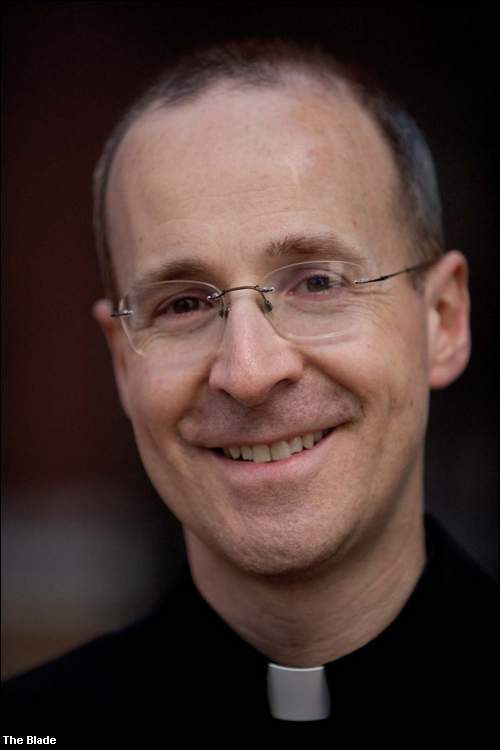By David Yonke
Toledo Blade
May 20, 2006
http://toledoblade.com/apps/pbcs.dll/article?AID=/20060520/NEWS10/605200316
Out of the thousands of saints in the Roman Catholic Church, the Rev. James Martin decided to choose just a few for his new book, My Life with the Saints (Loyola Press, $22.95).
"It's very personal. These are the 20 or so saints that have meant the most to me in my life and whose examples I follow," Father Martin said in a recent phone interview.
The Jesuit priest and author said he had no trouble choosing the saints he wanted to write about.
 |
| Rev. James Martin |
"On my bedroom wall, I have sort of an array of all of my favorite saints - the ones that I pray to," he said. "Over the years, I have put up holy cards and pictures. I picked the ones I spend a lot of time thinking about and praying to."
Among those he selected are Ignatius of Loyola, Therese of Lisieux, Joan of Arc, Mary, Joseph, Francis of Assisi, Peter, and Thomas Aquinas.
Some of the ones he selected are not officially saints yet but are in the process of becoming one, including Mother Teresa and Pope John XXIII.
"I think for most people, the image of the saint is of a plaster statue or a stained-glass window - someone whose life is largely irrelevant to our own," Father Martin said. "But when you read their stories, you find that these are real people who had real struggles and real joys as well. They were human."
Mother Teresa, for example, spent most of her life helping the poor of India and was beatified in October, 2003, but she had struggled through years of spiritual doubt, Father Martin said.
"Among her papers discovered after her death [in 1997] was this great secret that for many decades she struggled with doubt and great spiritual darkness," he said.
"She had this intense experience of God when she felt called to work with the poor, but shortly after that she was plunged into this spiritual darkness that most people don't know about."
Father Martin said Mother Teresa told her spiritual director that she wrestled with doubts about God's existence and of feeling abandoned by God.
Eventually the nun was able to use those feelings as a way of drawing closer to the poor who feel abandoned and to Christ who was abandoned on the cross, he said.
"Everyone assumes she had a hotline to God. They assume life was easier for her. And it turns out her life was harder. That makes her witness more inspiring, and it also reminds us that you can't leave all the hard work to the saints."
Knowing that saints are imperfect people can be an inspiration to those who might otherwise consider themselves spiritu-ally unworthy or are intimidated by the high standards associated with sainthood, Father Martin said.
The late Pope John Paul II canonized 82 saints and beatified 1,338 people - more than all his predecessors combined. Father Martin said one reason for the large number of beatifications by the late pope was to broaden the perception of sainthood, geographically.
Beatifying people from nations that previously had few saints was a way to encourage local churches, Father Martin said, because it demonstrated "that a person can be holy from that part of the world. Sanctity makes its home everywhere in the world, not just Rome and first-century Palestine or in a convent or a monastery somewhere."
He said the church needs to single out more parents, husbands, and wives to show how people in everyday occupations can be saintly.
"If you think about it, most of the saints are founders of religious orders, priests, or sisters. They have the benefit of a religious order or a diocese continuing their canonization process with all the paperwork and money required.
"Husbands or wives don't have the institution behind them. As a result, we don't have as many canonized husbands and wives as we should. Yet their state of life is as equally holy as anyone who lives in a monastery - if not more holy, getting up in the middle of the night to care for a child, which a priest doesn't have to do."
Father Martin said that, historically, the church has been prejudiced against married life and has favored the priesthood or religious vocations when considering sainthood. That prejudice has been changing since the Second Vatican Council of the 1960s, which gave more recognition to lay persons, he said.
Any original material on these pages is copyright © BishopAccountability.org 2004. Reproduce freely with attribution.